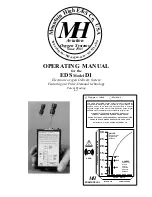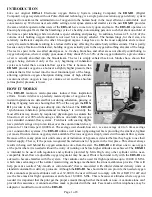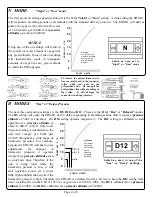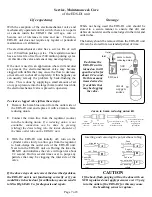
Page 6 of 8
Display Information
There are two high brightness LEDs on the EDS model D1. The green LED indicates positive oxygen flow for every breath. The red
LED indicates any flow fault or apnea conditions and blinks for low battery conditions.
FLOW FAULT ALARM
The EDS model D1 will produce an optical (red LED) and audible flow fault alarm from the following reasons:
1. The oxygen supply has been removed.
2. The supply line has become pinched closed, is plugged up or has come off.
3. The battery no longer has the power to energize the valve while under pressure or the valve or line has become plugged
APNEA ALARM
The EDS model D1 will produce an optical (red LED) and audible apnea alarm for the following reasons.
1. The user has quit breathing over a 45 second period.
2. The outlet (cannula) tube has become disconnected.
3. The outlet (cannula) tubing has become pinched closed or is plugged off.
NOTE:
The audio portion of these alarms can be disabled by momentarily (about 1/3 of a second) selecting the "OFF" setting from the "N" setting
and back on to any on settings. The audio alarm will be re-enabled any time the unit turned off for more that two (2) seconds before it is
turned back on.
Low Battery:
The EDS model D-1 unit continuously monitors the condition of the battery during operation. The unit flashes the red LED once every
two seconds to warn that the battery has dropped to about 6 volts. The unit will, however, continue to operate properly for about four (4)
hours @ 25° C after the indicator starts to flash. It will flash the red LED once per second to warn that the battery has dropped to about 5
volts and should then be replaced ASAP. The EDS model D1 will operate for 60 to 80 hours with a fresh alkaline battery under normal
operation. However, because a very small amount of current (
≈
1 µa.) is drawn by the unit while turned off, the battery life is about 4 to 6
months. Therefore, during long term storage the battery should be removed. Once the battery drops below 5 volts the unit will stop
operating and the red LED will remain on.
External Power:
The EDS model D-1 unit has an external power coaxial type connector (jack). It allows the unit to operate from an external power supply
that provides 7 to 10 volts @ 100 ma. peak current with less than 150 mv. ripple and filters spikes from the primary power bus such as the
EDS-EPS (External Power Supply). The connector is reversed from that of our EDS model A unit. That is, with the EDS model D the
inside pin "tip" is negative (-) and the outside ring is positive (+). A reverse polarity diode 1. A. in the EDS unit helps prevent damage
from accidental short term reverse voltage occurrences.
Misc. notes:
The EDS model D1 has a basic (total) apnea detector. It will only respond with an apnea alarm for total apnea (no event) conditions and
will not consider or respond to any partial apnea conditions. That is, the EDS D1 unit will only produce the apnea alarm if it has not
detected any respiration actions for a period of 45 seconds. Any respiration events within this time will reset the 45 second "time-out"
apnea detector. This type of apnea detection is usually sufficient for aircraft and high altitude (non medical) applications. The apnea
alarm can be used as a "put-your-oxygen-on" alarm once you get to the preset D1 mode altitude. The apnea alarm will not sound if you
already have the cannula or face mask properly on.
The EDS unit is calibrated to deliver just over 2 times more than the equivalent flow-rate of 1 liter/min. per 10,000 ft. This is the standard
FAR protocol as detailed in 23.1447. It can only do this if the regulator feeding the EDS unit can deliver a flow-rate of 25 liters/min. as
measured at the regulator's outlet or a pressure of 1 bar (
≈
15 psig.) during flow (dynamic) and not during no-flow (static) conditions. This
flow-rate is required to compensate for normal flow losses in the lines, valve and cannula. A flow-rate of 10 liters/min. is needed at the
end of the cannula. EDS delivery calibration augmentations can be done by adjusting the inlet dynamic pressures of the regulator feeding
the unit. Lower pressures result in lower amounts of oxygen. Higher pressures result in higher amounts. Adjustable flow-rate regulators
can be used while the unit is in the R/M setting. Static (no-flow) pressures can be as high as 35 psig. without the user becoming aware of
the increase. Higher inlet pressures will demand more from the battery. Therefore, a low battery that operates the unit sufficiently at 15
psig. may have trouble opening the valve at an inlet pressure at 35 psig., thus causing an occasional flow-fault alarm. Simply replace the
battery to remedy this. If the inlet pressure is too high the valve may not open at all and cause the flow-fault alarm for every inspiration
effort.
Do not store the EDS unit while the inlet is under pressure. Remove all sources of oxygen pressure and secure the unit to ensure it will not
become damaged. If the lines are disconnected they must be covered so that debris, dust or dirt can't get in. If the supply line is left
hooked to the system, make sure that it is first purged with clean dry air or oxygen before the EDS unit is connected.






























